2020 – August news: Roasting
Regular readers of Canalside news will know I love a weather stat, and this week has delivered a few – England has recorded temperatures upwards of 34 degrees for 6 successive days in a sequence that included the third hottest August day for 17 years.
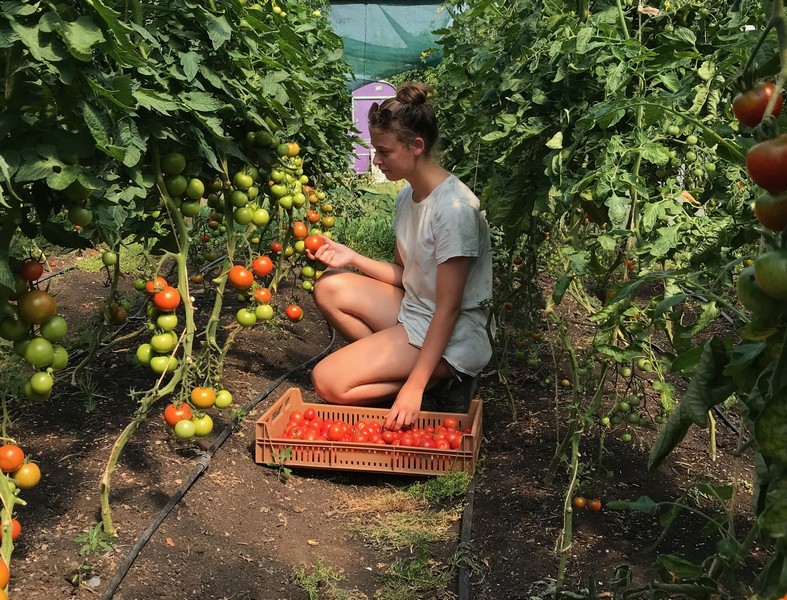
Heatwave harvesting
Photo: Magali Fowler
Bean bonanza
Photo: Magali Fowler
Cucumber TLC
At the farm it has been challenging to say the least for land workers, not to mention the plants – thankfully thunderstorms have brought much-needed rain to quench their thirst. The downpours have helped arguably the most important crop on the farm to germinate nicely: the grass-clover green manure leys that are the biological powerhouse behind our soil fertility. Green manure replenishes soil nutrients and regenerates soil health as well as providing habitat for insects, and it is always a huge relief to see it germinating well!
Dom van Marsh, head grower
Rebecca’s Recipe of the Week: Seared Courgettes with Black Pepper and Cheese
This week’s recipe is from Matt. He says: ‘This is really simple but very tasty way of cooking courgettes to their best’. It’s based on a classic Italian pasta dish called caccio e pepe, in which the pasta is dressed with grated cheese and lots of black pepper. That combination turns out to work equally well on courgettes.
This dish is delicious served with sausages, or some grains tossed with pesto, which, incidentally, is a further good use of the bountiful crop of basil we’re currently enjoying from Canalside.
Seared Courgettes with Black Pepper and Cheese
Serves 3-4
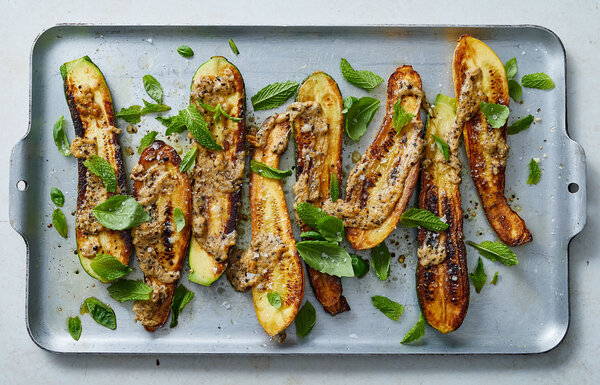
Ingredients
700g courgettes
3 tablespoons oil
Salt
2 teaspoons coarsely ground black pepper
4 tablespoons butter, cut into 4 pieces
50g hard cheese, grated
Handful of basil and/or mint leaves, torn into pieces
Preparation
Halve the courgettes lengthwise. If they are large, cut them into lengthwise quarters. Cut each length into 5-7cm sections. Sprinkle them with salt.
Heat the oil in a large, heavy frying pan for 2 minutes over medium-high heat. This will help you get a good sear on the courgettes. Once the oil shimmers, begin to sear the courgettes. You will need to do this in several batches so as not to crowd the pan—they need to be in a single layer. In batches, lay them cut side down in the hot oil and leave them undisturbed for 2-3 minutes, or until they begin to turn golden brown. Flip them over and cook for another 2-3 minutes on the other side, ensuring all sides are seared and golden brown. Remove them from the pan, setting them aside on a serving platter, and repeat with the remaining courgettes.
While the final batch cooks, add the pepper to a small saucepan and toast over medium-high heat for about 2 minutes, or until it becomes fragrant. Add the butter, which will quickly start to foam. Stir until the butter is melted and the foam subsides. Remove from the heat and quickly add the grated cheese. Stir vigorously, so the cheese doesn’t stick to the bottom of the pan. It will begin to melt, but will also cling together in pieces, which is the result you want.
Spoon the butter over the seared courgettes, making sure to include all the black pepper and melted cheese. Scatter the herbs over the top and serve.
Recipe adapted from NYT Cooking
Rob’s Recipe of the Week: Huauzontle fritters
This week we’re getting an unusual vegetable, Huauzontle. After a fair bit of digging it seems it’s impossible to talk about Huauzontle without mentioning the dish “Tortas de Huauzontle”, which are small battered and deep fried fritters of Huauzontle and cheese, so that has to be my recipe for this week. If this doesn’t take your fancy though it seems the best alternative is to treat it like broccoli, maybe by sauteing with onion/garlic/cumin/vinegar.
Tortas de Huauzontle

Ingredients (will need scaling according to your share):
Tortas:
1 1/2 liters Water
1 teaspoon salt
4 cups huauzontle, clean, without branches
190 grams cream cheese (or alternative)
1/2 cups flour
4 egg whites (For batter. For vegan alternative try a gram flour batter)
4 egg yolks
enough oil, to fry
Sauce:
3 pasilla chili peppers (deveined and soaked – try canalside dried chilis but beware they’re much hotter)
2 tomatoes
1/4 onions
2 cloves garlic
1/2 cups Water
2 tablespoons oil
salt
Method:
Cook huauzontles in salted water for 5-10 minutes (cook time varies wildly from recipe to recipe, cook for longer if you’re only shallow frying I think)
Place the huauzontles in a bowl of water with ice.
Remove the huauzontles and dry on a tea towel to remove moisture.
Strip everything from the bitter stalk and discard this.
Form a burger like patty in your hands by squeezing the huauzontle around a chunk of cream cheese, flouring the outside.
In a blender beat the egg whites with a pinch of salt, until peaks form
Add the yolks and beat for 1 minute more to integrate.
Dip the huauzontle pancakes in the batter.
Heat the oil over medium heat and fry 2 minutes on each side. (Make the sauce first)
For the sauce, blend the chilies, tomato, onion, garlic and water for 3 minutes.
Heat the oil over medium heat, pour the sauce, season with salt and let it cook for 15 minutes.
Serve the huauzontle pancakes bathed in pasilla sauce.
Recipe adapted from:
https://us.kiwilimon.com/recipe/main-dishes/huauzontle-pancakes-with-sauce-from-chile-pasilla
https://www.atastefortravel.ca/3408-huauzontle-puerto-escondido-mexico/#wprm-recipe-container-12833
Rebecca’s Recipe of the Week: Lebanese Tabouli
When I was growing up, tabouli formed part of my father’s very limited cooking repertoire, alongside steak tartare and chicken marsala. The recipe he used called it ‘non-lettuce salad’, and that’s a good description of this blend of parsley, mint, tomatoes, cucumbers and a little bulgar wheat. I dedicate this recipe to him!
The secret to this tabouli is the Lebanese 7-spice blend. For an absolute feast, serve it with Lebanese 7-spice chicken. It’s pretty good on its own, too.
Lebanese Tabouli
Serves 4
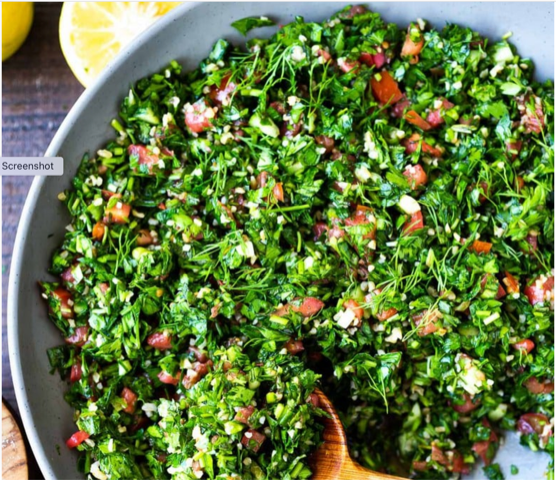
Ingredients
7 Spice Blend Ingredients
1 teaspoon ground coriander
1 teaspoon cumin
1 teaspoon cinnamon
1 teaspoon ground allspice
1/2 teaspoon grated nutmeg
1/2 teaspoon ground cloves
1/2 teaspoon ground cardamom
Tabouli ingredients
250ml dry medium grain bulgar wheat
4 spring onions
1 large bunch flat-leaf parsley
1 cup mint leaves
1 small bunch dill
3 medium tomatoes
1 cucumber
1 tablespoon lemon zest
70ml lemon juice, or to taste
125ml cup olive oil
1 teaspoon salt
1 teaspoon 7-Spice mix
Preparation
First prepare the 7-spice blend. This will make more than you need for the tabouli, but that shouldn’t be a problem since it’s so delicious. You can add it to lots of other things, including this splendid Lebanese 7-spice chicken. To make the blend combine all the ingredients together. If you want really to go to town with it, you can roast whole coriander and cumin seeds and then grind them, before combining with the other ingredients. This gives an added warm depth to the spice blend.
To make the salad, first prepare the bulgar wheat. Put it in a small bowl and pour 250ml boiling water over it. Cover with a plate, and set aside for at least 30 minutes while you prepare the rest of the salad. This allows the grains to soften.
Slice the spring onion and place in a large serving bowl.
Chop the parsley as fine as you can. It’s ok to include the thinner stems. Add to the bowl. Chop the mint and dill and add them as well.
Dice the tomatoes and cucumbers into small cubes and add them to the bowl, along with all their juices.
Add the lemon zest, lemon juice, olive oil, salt and 1 teaspoon of the 7-spice mix. Give it all a good stir.
By now 30 minutes have probably passed, so the bulgar wheat should be al dente. Once it is, add it to the salad as well and mix again.
If you have time, let the salad sit for a few hours to allow the flavours to meld. The parsley will soften and the bulgar will soak up the flavourful juices. It will in any event be very good the next day if there is any left over.
Before serving, give a stir and taste for salt, lemon and 7-spice. Adjust to your liking. Slyvie Fountaine, whose recipe this is, says ‘You want just the faintest whiff of the spices, like a whisper’.
Recipe adapted from Sylvia Fountaine, ‘Feasting at Home’. https://www.feastingathome.com/lemony-tabouli-aka-tabbouleh/
Rob’s Recipe of the Week: A Provencale Tian
Text and photo from: https://www.cuisinefiend.com/242/courgette-and-spinach-tian
What’s a tian? In spite of sounding rather middle-Eastern or even oriental, it’s a Provençal pan made of clay, enamelled in bright colours, which they use to cook vegetable gratins in. Or, indeed, tian, as it’s also the name of the dish.
They sell tian pottery at the markets all over Provence and you can hardly pass by the stalls without stopping to admire the vivid colours, the glaze and the various shapes. If pottery wasn’t fragile and rather heavy, I’d have a collection brought over from my French voyages… As it is I need to use boring mass-produced vessels to cook my tians et al in.
They come in all sorts, being basically roasted vegetables with cheese. Rice is a common ingredient, sometimes potatoes, and spinach is a veritable tian king. Eggs are frequently added but I skipped them here, aiming for a less quiche-y flavour. And make a note of the courgette treatment – that’s how this boring vegetable needs to be handled. Squeeze the living daylights out of it and it might just be vaguely tasty.
Courgette and Spinach Tian
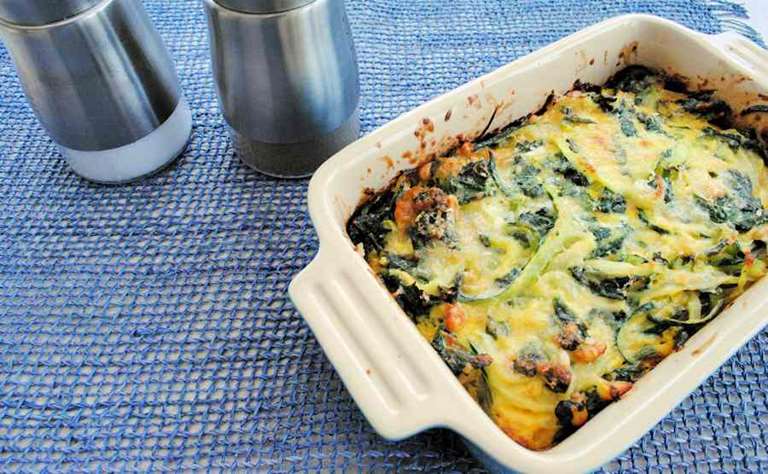
INGREDIENTS
1 large courgette
200g fresh or frozen spinach (thawed)
2 tsp sea salt
2 cloves of garlic, peeled and finely chopped
2 spring onions, chopped
a handful of pine nuts
60ml double cream
1 egg yolk
30g grated hard cheese, Gruyere or Cheddar
20g grated Parmesan
a little olive oil
METHOD
- Wash, top and tail the courgette and cut it into ribbons or noodles on a mandolin or in a spiralizer. Sprinkle with salt, stir it around and place in a colander for at least 10 minutes. After that time rinse it with cold water, squeeze out as much moisture as you can without squashing the courgette, and pat dry with paper towels.
- Rinse the spinach, if using fresh, and wilt it in a microwave or blanch briefly in boiling water. When cool, squeeze out the liquid and chop finely.
- Mix the cream with the egg yolk and add the hard cheese. In a bowl mix the courgette with spinach, pine nuts, garlic and spring onions and most of the Parmesan. Pour over the cream mixture and stir through.
- Preheat the oven to 220C/425F/gas 7.
- Drizzle a little olive oil in the bottom of a tian or gratin dish, transfer the vegetables into it and sprinkle with the remaining Parmesan. Bake for 20 minutes until brown and bubbling. Best serve very warm, instead of piping hot.
From https://www.cuisinefiend.com/242/courgette-and-spinach-tian
2020 – July news: Fine Young Cabbages
I’ve seen cabbages, and I’ve seen cabbages, but I’ve never seen cabbages like this before – not in July, at any rate. Planted just 6 weeks ago these plants have exploded in size and are glowing with health. The work morning teams have been going through clearing out any remaining weeds but the great thing about massive brassicas like these is that the canopies close up to shade out any weeds underneath – meaning we won’t need to go near them again until harvest. Right now you’re experiencing the benefits of this brassica boom with the kale that’s been in the share lately; I wouldn’t normally expect the first pick so early but somehow this year the soil, weather conditions and help in the fields from our marvellous volunteers have combined to give a bountiful early crop.
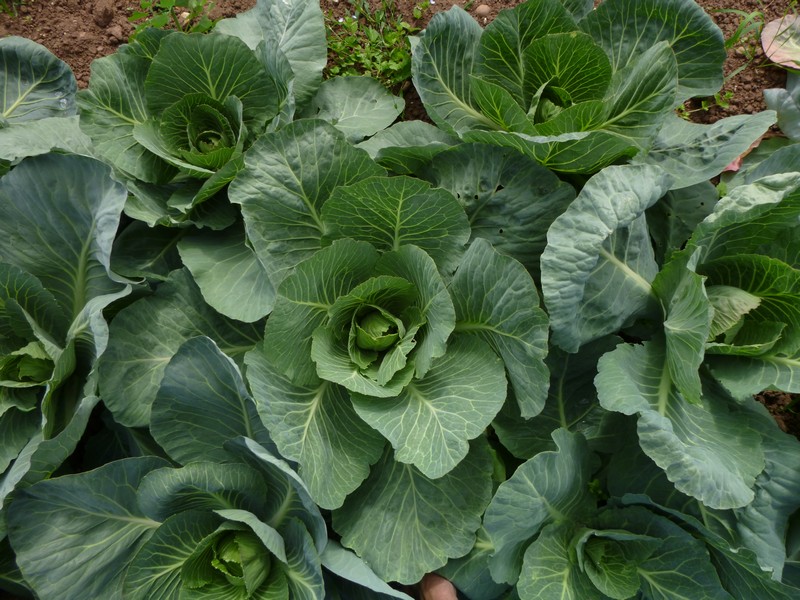
Rebecca’s Recipe of the Week: Crushed Carrots
This is a spectacular recipe: the combination of carrots, harissa, and lemony yoghurt is inexplicably delicious. It looks particularly lovely served on a blue plate, and makes an ideal accompaniment to another Ottolenghi showstopper: his warm lentils with tahini.
Crushed Carrots with Harissa and Nuts
Serves 4
Ingredients
1 tablespoon olive oil, plus extra to finish
1 tablespoon butter
1kg carrots, peeled and sliced 2cm chunks
200ml water
grated zest of 1 orange
1 clove garlic, crushed
2 teaspoons harissa paste, or to taste
grated zest of 1 lemon divided into two portions
1 tablespoon lemon juice
150g Greek yogurt
25g shelled unsalted pistachios or cashews, coarsely chopped
Salt and black pepper
Instructions
Place the olive oil and butter in a sauté pan over medium-high heat. Add the carrots and sauté for 6 minutes, stirring often, until they’re soft and take on colour. Add the water, reduce the heat to medium-low, cover the pan, and cook for another 25 minutes, until carrots are completely soft and perhaps a little caramelised, and there is hardly any liquid left.
Transfer the carrots to a food processor, add 3⁄4 teaspoon salt, and blitz to form a coarse paste. Leave to cool, then add orange zest, garlic, harissa, one portion of the lemon zest and the black pepper to taste. Stir to combine.
Mix the yogurt, lemon juice, remaining lemon zest, and 1⁄4 teaspoon salt.
Spread the yogurt mixture on a blue serving platter and spoon the carrots on top. Sprinkle with nuts, drizzle with a little olive oil, and serve.
Recipe adapted from Yotam Ottolenghi, Plenty More (2014).
Rob’s Recipe of the Week: Swedish Summer Sandwich
This week’s recipe is a little niche if you stick to the vegan recipe, especially now that IKEA has closed in Coventry, but it can be adapted with other seafood flavours (the most obvious being actual seafood e.g. prawns). At worst, at least I’m giving you a quick and easy vegan mayo recipe… It’s another that I picked up in Sweden and is an adaptation of the dish “Skagen” which is a sort of seafood toast topper/sandwich filler (£6 for a baguette in the Volvo canteen ouch!). For a while it was my absolute favourite breakfast when combined with cucumber, salad and tomatoes all of which will be abundant in the shares over summer.
Vegan Skagen

Dry Ingredients:
- 1 jar Seaweed pearls (AKA veggie caviar, available at IKEA)
- Bunch of dill
- 1 pack of tofu, drained and squeezed as much as possible whilst maintaining solid chunks
Mayo:
- 100ml Soya milk (must be soya – I’ve tried with others but they refused to emulsify with the oil)
- 1 tbsn lemon juice
- 1 tsp mustard
- 200 ml oil (preferably rapeseed, other veggie oils work but again can have trouble emulsifying)
To serve:
- Toast
- Lettuce
- Tomato
- Cucumber
- Wedge of lemon (optional)
Method:
For the mayo, combine milk, lemon juice and mustard in a blender (handheld will do) before SLOWLY adding oil as a thin stream whilst blending on a fairly high speed. As you get to the end of the oil the mixture should thicken up to a mayonnaise texture.
Then combine all ingredients in some Tupperware and serve with toast, sliced cucumber/tomato and lettuce. A lemon wedge is a nice addition if you have it.
Rebecca’s Recipe of the Week: Smashed Cucumber Salad
This is an ideal recipe when you have 4 or 5 cucumbers looking at you from the bottom of your veg drawer. Smashing the cucumbers, which is apparently a classic Chinese recipe technique, changes the texture by making them more absorbent so they really soak up the dressing. It’s refreshing, easy, and makes an excellent accompaniment to an Asian-style noodle dish, such as this one for sesame noodles with smashed courgettes by Meera Sodha. (By the way, I served the noodle dish warm, which worked just fine.)
Chinese Smashed Cucumbers with Sesame Oil and Garlic
Serves 4 as a side dish
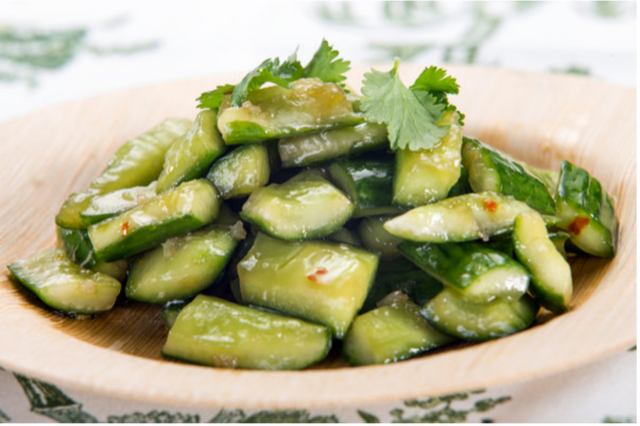
Ingredients
4 cucumbers
Salt
Sugar
1½ tablespoons rice vinegar
2 teaspoons sesame oil
2 teaspoons soya sauce
2 garlic cloves, grated
½ -1 Canalside chile, minced (to taste)
Small handful fresh coriander, chopped, for garnish
1 tablespoon toasted sesame seeds, for garnish
Preparation
Top and tail the cucumbers, and cut lengthwise into 4 long strips. Cut each strip into bite-sized pieces.
Using a rolling pin or (this is the less messy option) the side of a large knife, crush the cucumber pieces so that the skin begins to crack and the insides break down, releasing some of the seeds.
Place the crushed cucumber pieces in a colander and toss with a big pinch of salt and another of sugar. Fill a plastic bag with ice and place this on top of the cucumbers pieces, to weigh them down and at the same time chill them a bit. Leave for anywhere from 15 minutes to 4 hours.
Meanwhile, make the dressing: mix 1 teaspoon salt, 2 teaspoons sugar, and the rice vinegar. Stir until the salt and sugar have dissolved and then add the sesame oil and soya sauce.
When you are ready to serve, shake the cucumbers to drain off any remaining liquid and transfer to a beautiful flat plate. Toss with about half the dressing, and then add the garlic and as much chile as you like. Toss again, and then add more dressing to taste, until you’re pleased with the ensemble. Serve, garnished with fresh coriander and toasted sesame seeds.
Recipe adapted from New York Times Recipes.
Rob’s Recipe of the Week: Fancy Mash
Kohlrabi returns to the share this week and whilst I’m not sure mashed potato is really hot-weather suitable, this recipe looked too good to miss. This recipe makes a lot but can be scaled to suit your share size.
Mashed kohlrabi with brown butter
4 servings
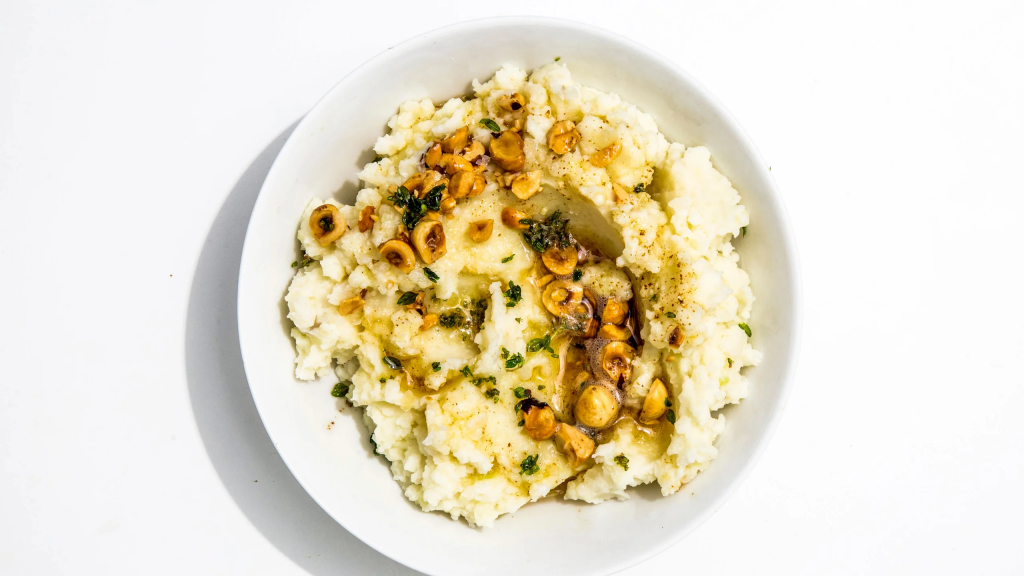
Ingredients
6 tablespoons unsalted butter
⅓ cup blanched hazelnuts
4 thyme sprigs
450g potatoes, peeled, cut into 2cm pieces
salt
900g kohlrabies, peeled, cut into 1cm pieces
⅓ cup double cream
Method
Heat butter in a small saucepan over medium. Cook hazelnuts until butter foams, then browns, about 5 minutes. Add thyme sprigs and cook until crisp, about 30 seconds. Immediately transfer to a bowl; spoon out nuts and coarsely chop.
Meanwhile, boil kohlrabi for 12-14 minutes, adding potatoes to the same pan after a couple of minutes. Whilst you wait, heat cream in a small saucepan over medium until warm.
Drain potatoes/kohlrabi and mash them. Stir in brown butter and warm cream; season with salt. Top mash with hazelnuts and crumble fried thyme over.
Taken from: https://www.bonappetit.com/recipe/mashed-kohlrabi-with-brown-butter